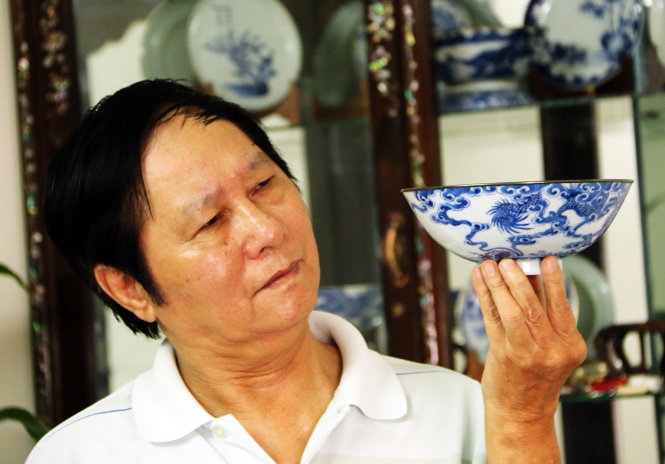A debate over the genuineness of a batch of ceramic antiques, including dishes and bowls, has been ongoing in the central province of Thua Thien-Hue for the past decade.
>> An audio version of the story is available here
>> Trading antiques in Vietnam – P1: Tricks to sell fake objects>> Trading antiques in Vietnam – P2: How to cheat buyers?>> Trading antiques in Vietnam – P3: Statue made of metal fetching ‘$80mn per kg’
It is claimed that the items were used in a royal palace of the Nguyen Dynasty over a century ago.
However, no one has ever been able to confirm whether the items are real or fake.
In the world of lovers of antiques in Hue City, the capital of the province, many still say the batch, which is kept at the Thua Thien-Hue Museum of History and Revolution, is authentic.
In the meantime, others have asserted that it is simply counterfeit.
Bogus or real?
One evening in 2001, Nguyen Xuan Yen was about to close his antique shop, located at 51 Le Loi Street in Hue.
Then a young man entered and watched his antiques displayed in glass cabinets for a while and left.
The young man returned the following day with a big bag on his shoulder. He smiled to greet the shop owner, Yen, and offered a special batch of 11 ceramic dishes and bowls.
He said he came from the northern province of Nam Dinh and sold the batch for his relative back home.
The ceramic dishes and bowls were said to be owned by a royal descent, previously residing in a locality along the Tam Giang Lagoon, and sent home by former queen mother Tu Du.
Seen with the naked eye, the seeming antiques were surprisingly beautiful and alluring.
Yen had dreamed of the items long before. They included nine tea dishes and two bowls sophisticatedly decorated with dragons and landscapes such as rivers and mountains.
The young man said the 11 pieces were used in the royal citadel of the Nguyen Dynasty at least over a century ago.
The items are named “do su ky kieu,” which means the ceramics that the royal dynasty in Vietnam requested manufacturers in China to make.
After watching the objects carefully to check their authenticity, Yen decided to buy them all at VND38 million (US$1,700) in total.
Then, he invited friends, many of them antique connoisseurs, to examine the dishes and bowls.
All agreed that they looked extremely beautiful.
“Honestly, I must say that they were genuine because they looked perfect and very sophisticated.
“But I was wondering why there were so many antiques from the royal dynasty like that,” Nguyen Van Thang, the owner of an antique shop nearby, recalled.
An expert in restoring royal ceramics in Hue was invited to check the batch.
“He didn’t confirm if it was genuine or fake,” Yen said.
“He just watched the items carefully at every corner and said: ‘There is some doubt.’
“I took a closer look at them for a while later and finally came to a conclusion that they were all fakes.”
One day later, the young man from Nam Dinh arrived at the store of Yen and asked if he wanted to buy more.
He recommended many more dishes and four big bowls embellished with royal images such as unicorns, lotus flowers, dragons, phoenixes, rivers, and mountains.
Yen had secretly reported to police officers about the young man allegedly selling fake antiques.
The young man, Yen, the 11 items, and cash were then sent to a police station in Hue.

A fake ceramic dish antique. Photo: Tuoi Tre
At the police station
At the Hue police station, the young man presented certificates to prove the origin of the objects.
Police temporarily seized the items for further investigation since it is illegal to sell and buy antiques without licenses granted by relevant authorities.
A team of investigators was put together to confirm if the batch was genuine or fake.
Nguyen Xuan Hoa, former director of the culture department of Thua Thien-Hue, led the investigative team then.
“Actually, we felt uncertain but the seller had the certificates to prove the origin of his purported antiques,” Hoa said. “And the pieces looked very beautiful.
“But some experts said they are counterfeits.”
The seller was later released because he had provided enough papers.
Hoa decided to buy the entire batch to display at the Thua Thien-Hue Museum of History and Revolution.
The antique shop owner Yen mentioned several details to prove the items are fake. They include the details at the end of the dragons that are different from those painted under a royal dynasty.
Yen added that the enamel of the dishes looks less sharp than that of a genuine antique.
And finally, one single authentic antique dish is worth VND1 billion ($44,500), not just tens of millions of dong, Yen asserted.
But there has been no official conclusion from professional experts so far on the genuineness of the batch of ceramic dishes and bowls.
Phan Tien Dung, director of the Department of Culture, Sports and Tourism of Thua Thien-Hue, has said he will arrange for the verification of the authenticity of the items.
Like us on Facebook or follow us on Twitter to get the latest news about Vietnam!





















































